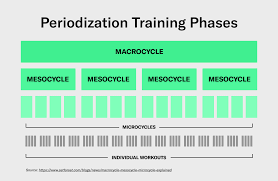Periodization in Muscle Building: Unlocking Your Full Potential
Periodization is one of the most effective, science-backed strategies for maximizing muscle growth, strength gains, and overall performance. Whether you’re a beginner looking to get into shape or a seasoned bodybuilder striving for peak performance, incorporating it into your training plan can take your results to the next level. In this article, we’ll explore what periodization is, why it’s so important, and how to implement it in your workout routine for optimal muscle building.
What is Periodization?
Periodization refers to the structured and planned manipulation of training variables (such as volume, intensity, and frequency) over specific time periods to optimize performance and muscle growth.
Instead of constantly performing the same type of workout, periodization breaks training down into phases to prevent plateaus, reduce the risk of injury, and ensure long-term progress.

What are the 3 phases of periodization training?
There are three main phases in periodization:
Macrocycle: The long-term cycle that typically spans 6 months to a year, covering the overall training plan and peak performance goals.
Mesocycle: A specific block of training within the macrocycle, lasting anywhere from 3 to 6 weeks, focusing on different aspects of training (such as strength, hypertrophy, or power).
Microcycle: A shorter training block, often lasting a week, where specific exercises, intensity, and volume are tweaked to align with the larger goals of the mesocycle and macrocycle.
Why Periodization is Key for Muscle Building
Preventing Plateaus: When you do the same workouts repeatedly, your muscles adapt, and progress slows down. Planning your workouts helps you cycle through different training phases, continuously challenging your muscles in new ways to promote growth and prevent stagnation.
Optimizing Recovery: Training intensely for extended periods without proper recovery can lead to overtraining and injury. By adjusting your training loads and intensity, planning your workouts allows you to maintain high performance while ensuring adequate rest for recovery and muscle repair.
Boosting Strength and Power: It helps you balance your focus between different types of training—strength, hypertrophy (muscle growth), and endurance—allowing you to increase your muscle-building potential by emphasizing one area at a time without sacrificing others.
Long-Term Success: With proper planning and progression, periodization helps you avoid burnout and promotes sustainable gains over time. Rather than relying on “quick fixes” or extreme programs, you build strength and muscle at a steady, consistent pace, with better results.
Types of Periodization for Muscle Building
Linear Periodization:
This traditional form and starts with high-volume, low-intensity training and gradually shifts to low-volume, high-intensity training. It’s great for beginners as it focuses on building strength and muscle over time.
Example:
- Week 1-4: 3 sets of 12-15 reps (light weight, focus on hypertrophy)
- Week 5-8: 4 sets of 6-8 reps (moderate weight, focus on strength)
- Week 9-12: 5 sets of 3-5 reps (heavy weight, focus on power)
Block Periodization:
This method breaks training into distinct “blocks” where each block focuses on a specific type of training (strength, hypertrophy, or power). This is ideal for advanced athletes who want to fine-tune specific aspects of their training.
Example:
- Block 1: 4-6 weeks of hypertrophy training
- Block 2: 4-6 weeks of strength training
- Block 3: 4-6 weeks of power training
Non-Linear (or Undulating) Periodization:
Undulating periodization fluctuates intensity and volume on a more frequent basis (weekly or even daily). It keeps your body guessing and continuously adapting, helping you avoid plateaus and overtraining.
Example:
- Monday: High volume, low intensity (12 reps)
- Wednesday: Moderate volume, moderate intensity (8 reps)
- Friday: Low volume, high intensity (3-5 reps)
Conjugate Periodization:
Focuses on training multiple qualities simultaneously, like strength, speed, and endurance, using different exercises to target these aspects.
Example:
- Monday: Max Strength (Low volume, high intensity, 3-5 reps)
- Wednesday: Speed/Power (Moderate volume, moderate intensity, 5-8 reps)
- Friday: Hypertrophy (High volume, low intensity, 10-12 reps)
How to Implement Periodization in Your Muscle Building Routine
To get the most out of periodization, here are a few practical steps to follow:
Set Your Long-Term Goals: Identify what you want to achieve in the long term. Whether you want to increase muscle mass, improve strength, or enhance endurance, knowing your end goal will help guide the structure of your plan.
Break Your Goals Into Phases: Depending on your goal, break down your macrocycle into specific mesocycles and microcycles. For example, if you’re aiming for muscle growth, your first mesocycle might focus on higher volume and moderate intensity, while the second may emphasize strength gains with lower reps and heavier weights.
Track Your Progress: Regularly assess your performance in each phase. Keep track of your weights, reps, and overall performance. If you’re not seeing progress, it might be time to tweak your program.
Incorporate Recovery: Periodization isn’t just about lifting heavy weights; it also emphasizes recovery. Make sure you’re allowing your body to rest and repair during deload weeks or during lighter phases of training.
Stay Flexible: While periodization is structured, it’s important to stay adaptable. If you feel like you’re overtraining or not recovering enough, it’s okay to adjust your intensity, volume, or frequency.
The Power of Periodization for Hypertrophy
Periodization is a game-changing tool that professional bodybuilders and athletes use to optimize their training and unlock their full potential. By incorporating it into your workout routine, you can prevent plateaus, maximize muscle growth, improve recovery, and see sustainable results over time.
If you’re ready to take your muscle-building journey to the next level, don’t wait—start training today! Whether you choose linear, undulating, or block periodization, the key is consistency, smart planning, and continuously challenging your body.
Thanks For Reading!

